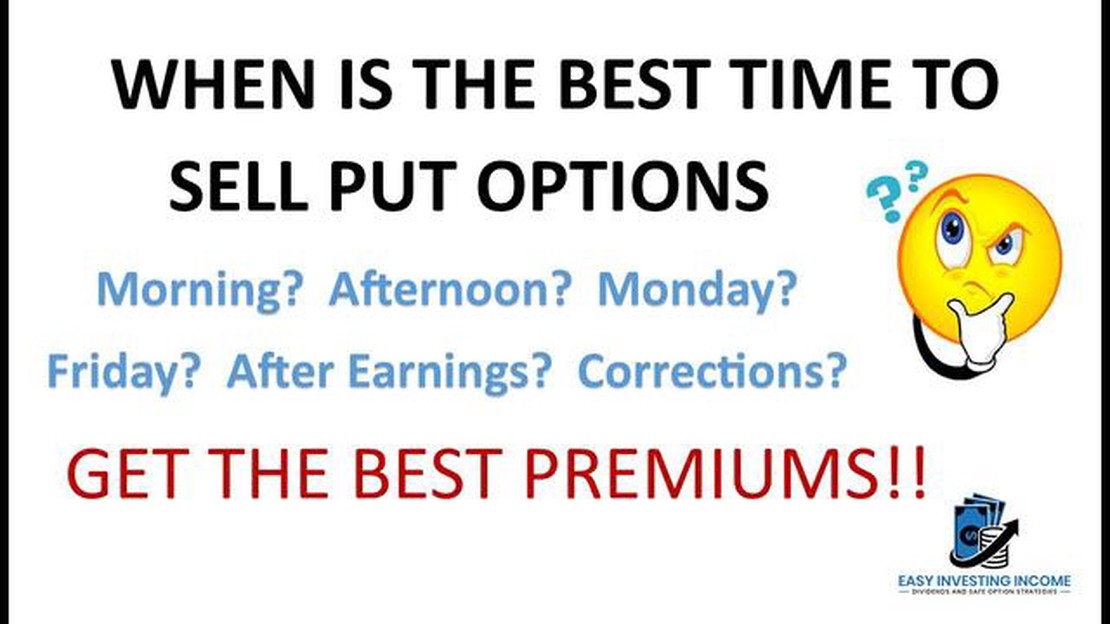Binary Options or Forex: Which Should You Trade?
Trading Binary Options vs Forex: A Comparative Analysis Trading in the financial markets has never been more accessible and popular than it is today. …
Read Article
When it comes to options trading, selling puts can be a lucrative strategy for generating income or acquiring stocks at a lower price. However, timing is crucial when executing this strategy. The question many traders ask is: what is the best time frame to sell puts?
There is no one-size-fits-all answer to this question, as the ideal time frame to sell puts can vary depending on market conditions and individual trading styles. In this comprehensive guide, we will explore different time frames and factors to consider when determining the optimal time to sell puts.
Short-Term vs. Long-Term: One of the first decisions traders need to make is whether they want to engage in short-term or long-term put selling.
Short-term put selling involves selling puts with a relatively short expiration date, usually within a few weeks or months. This strategy is ideal for traders who want to take advantage of immediate market movements and generate quick income.
Read Also: Historical High of Silver: Exploring the Peak Prices throughout HistoryLong-term put selling entails selling puts with a longer expiration date, typically six months or more. This approach is suitable for investors who are willing to hold a position for an extended period and are confident in the long-term prospects of the underlying stock.
Market Volatility: Another important factor to consider when deciding on the time frame for selling puts is the level of market volatility.
In times of high market volatility, short-term put selling can be more profitable as option premiums are usually higher. However, this also means higher risk and potential for larger losses.
In contrast, during periods of lower volatility, long-term put selling may offer better risk-reward ratios. Option premiums tend to be lower, but there is often a higher probability of success and less potential for significant losses.
By carefully analyzing market conditions and adjusting their strategy accordingly, traders can find the ideal time frame to sell puts that aligns with their risk tolerance and profit goals.
The best time frame to sell puts depends on various factors, such as market conditions, your investment goals, and risk tolerance. Generally, shorter time frames, like a few weeks to a couple of months, can provide quicker profits but also carry higher risk. Longer time frames, such as several months to a year, may offer more stability and lower risk. It is important to assess market trends and conduct thorough research before deciding on the best time frame for selling puts.
Market conditions greatly influence the best time frame to sell puts. During a bullish market, shorter time frames may be more suitable as there is typically positive momentum and options premiums may be higher. However, during a bearish market, longer time frames may be preferred to allow for potential market recovery and to mitigate risk. It is essential to monitor market trends and adapt the time frame accordingly.
Selling puts with a shorter time frame can provide several advantages. Firstly, it allows for quicker profits as options contracts expire sooner. Additionally, shorter time frames may have higher options premiums, increasing potential returns. However, it is important to note that shorter time frames also carry higher risk due to the volatility and shorter exposure to potential market changes.
Read Also: Understanding the Rules and Regulations for Foreign Exchange in India
Selling puts with a longer time frame offers certain advantages. Firstly, it allows for more time to ride out market fluctuations, providing a more stable investment strategy. Longer time frames also provide opportunities for potential market recovery if the stock price decreases. However, longer time frames may have lower options premiums, resulting in potentially lower returns.
Investment goals and risk tolerance play a significant role in determining the best time frame to sell puts. If you have high-risk tolerance and want quick profits, shorter time frames may be suitable. However, if you have a more conservative investment approach and prioritize stability, longer time frames may be preferred. It is crucial to align your investment goals and risk tolerance with the appropriate time frame to achieve the desired outcomes.
The best time frame to sell puts depends on various factors such as market conditions and your individual risk tolerance. However, a commonly recommended time frame is between 45 and 60 days. This allows for a good balance between time decay and potential profitability.
Trading Binary Options vs Forex: A Comparative Analysis Trading in the financial markets has never been more accessible and popular than it is today. …
Read ArticleWhat does SMA say? Welcome to [Website Name], your one-stop source for insights and analysis on the latest news and trends in the SMA (Social Media …
Read ArticleTurkish Lira or Euros: Which Currency is Better to Take? When planning a trip to Turkey, one of the key considerations is what currency to bring. …
Read ArticleUnderstanding Stock Market Fundamental Analysis Welcome to our comprehensive guide on understanding stock market fundamental analysis. In the world of …
Read ArticleBest Times to Trade Forex in Australia If you are interested in forex trading and live in Australia, it’s important to know when the market is open …
Read ArticleWhat is the moving average ribbon? When it comes to technical analysis in the world of trading, one of the most commonly used tools is the moving …
Read Article